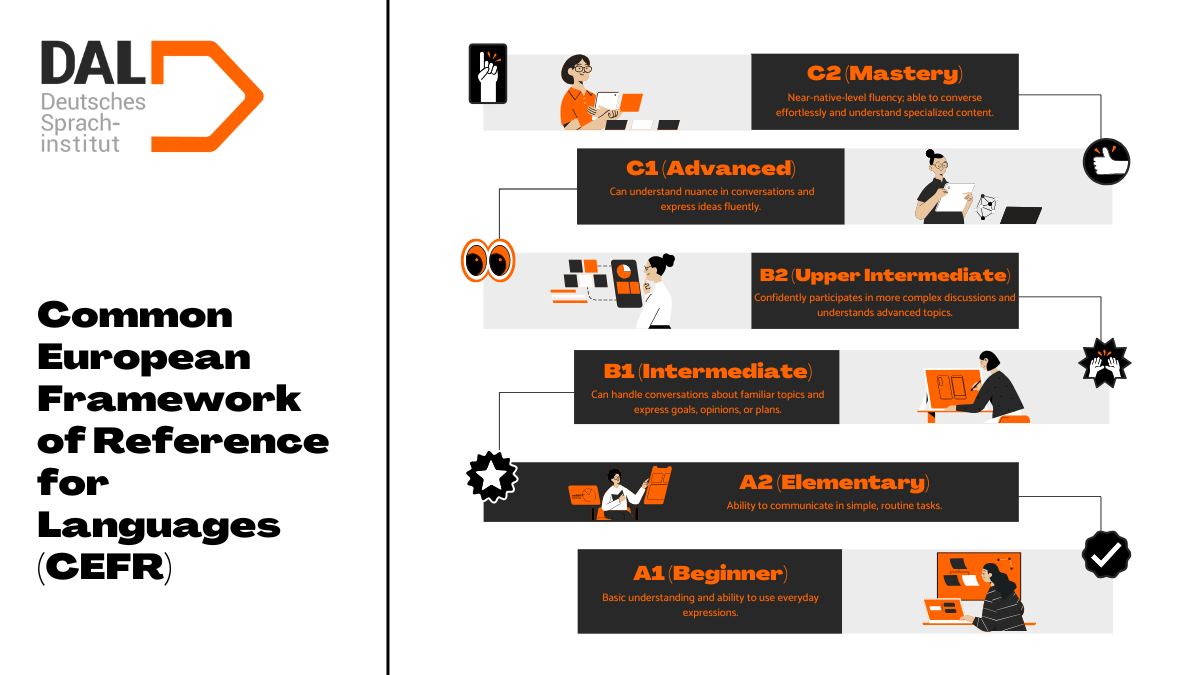If you’re starting your German learning journey, one of the first questions you might ask is, “How long will it take to become fluent?” The answer isn’t always straightforward because it depends on your goals, resources, and how much time you can dedicate. However, learning German online opens up a world of flexible tools and platforms to make your learning process more accessible and effective. By leveraging these resources in combination with an understanding of language proficiency frameworks, you can create a personalized and realistic path to fluency.
Understanding Proficiency Levels with CEFR
The Common European Framework of Reference for Languages (CEFR) breaks down proficiency into six levels. Many online language platforms and apps align their courses with this framework, making it easier to plan your studies and track your progress.
- A1 (Beginner): Basic understanding and ability to use everyday expressions.
- A2 (Elementary): Ability to communicate in simple, routine tasks.
- B1 (Intermediate): Can handle conversations about familiar topics and express goals, opinions, or plans.
- B2 (Upper Intermediate): Confidently participates in more complex discussions and understands advanced topics.
- C1 (Advanced): Can understand nuance in conversations and express ideas fluently.
- C2 (Mastery): Near-native-level fluency; able to converse effortlessly and understand specialized content.

Online resources not only consolidate your learning but also offer tailored experiences for advancing through these levels on your own schedule.
How Many Hours Are Needed?
Learning German is considered moderately challenging for English speakers due to its grammatical complexity and the presence of unfamiliar structures. Here’s a general estimate of the number of active learning hours typically needed to progress through each CEFR level:
- A1 (Beginner): 70-100 hours
- A2 (Elementary): 180-200 hours
- B1 (Intermediate): 350-400 hours
- B2 (Upper Intermediate): 500-600 hours
- C1 (Advanced): 700-800 hours
- C2 (Mastery): 1,000+ hours
Learning German online helps you optimize these hours with personalized study plans and progress tracking. With these tools, you can maximize every session, even during short daily breaks.
What Influences Your Learning Speed?
1. The Time You Dedicate
Consistency is key. One of the advantages of online learning is the flexibility it offers. Apps like Memrise gamify the experience, motivating you to maintain regular practice. Meanwhile, platforms like Lingoda offer structured live classes to help you stay accountable.
Casual learners (5 hours a week): Using lighter tools like Duolingo and language podcasts at this pace may mean it takes you several years to reach a B2 or C1 level.
Intensive learners (15-20 hours a week): Online platforms allow you to use your time strategically, potentially reaching B2 or higher within a year.
2. Immersion
While living in Germany is the gold standard for immersion, online tools enable you to simulate the experience from home. Stream German TV shows like Dark or Tatort, listen to German radio stations (e.g., Deutschlandfunk), and join platforms like Tandem to converse with native speakers in real time.
3. Learning Resources
The variety of online tools available enhances your learning in ways traditional classrooms often can’t. For instance:
- Vocabulary building apps like Clozemaster and Anki help improve retention.
- Structured lessons from Deutsche Welle provide free, CEFR-aligned courses.
- Speaking-focused platforms like iTalki connect you with tutors for one-on-one sessions.
- Immersive apps like Pimsleur or Rosetta Stone work on pronunciation and listening through real-world scenarios.
Combining multiple online resources creates a well-rounded learning experience. If you’re just starting your German learning journey, check out our guide on Learn German Online for Beginners for tips and resources to get started.
4. Your Native Language
Learning German online often feels intuitive for English speakers because many platforms highlight the shared roots between the two languages. For example, you’ll recognize cognates like “Haus” (house), which make vocabulary acquisition quicker than with unrelated languages like Chinese or Arabic.
5. Personal Motivation and Consistency
Many online language tools are designed to help you stay motivated. Features like streaks, badges, and leaderboards (seen in apps like Duolingo and Memrise) encourage regular practice. Setting small goals, such as mastering 10 new words daily or completing a single lesson, ensures steady progress.
How Long Could It Realistically Take?
Here are a few scenarios based on your dedication level, taking advantage of online learning:
Scenario 1: Casual Learner
- Time Commitment: 3-5 hours a week, using free tools like Duolingo and German podcasts.
- Goal: Conversational fluency (B1).
- Time Estimate: Around 2-3 years.
Scenario 2: Intensive Learner
- Time Commitment: 15-20 hours a week, combining structured courses (e.g., Lingoda) with speaking practice on iTalki.
- Goal: Academic or professional fluency (B2).
- Time Estimate: Around 1 year.
Scenario 3: Immersion Learner
- Time Commitment: 20+ hours a week, mimicking immersion through online resources like German TV shows, podcasts, and live tutoring.
- Goal: Near-fluency (C1).
- Time Estimate: 6 months to 1 year.
Tips to Speed Up Your German Learning
Online tools make rapid progress possible if used effectively. Here are some strategies:
- Create a Daily Routine
Dedicate at least 30 minutes to an hour every day. Apps like Quizlet or Anki are ideal for memorizing vocabulary quickly, while Lingoda offers daily live classes. - Immerse Yourself Online
Follow German influencers on Instagram or YouTube, subscribe to German-language newsletters, and engage with online forums like Reddit’s r/German. - Practice Speaking Early
Begin speaking from day one to improve faster. Platforms like Tandem or Hallo make it easy to find language partners or tutors to practice pronunciation. - Use a Mix of Resources
No single tool covers everything, so combine them. For instance, Deutsche Welle or Babbel can provide structured lessons, while iTalki or Speaky can help with real-world speaking practice. - Track and Celebrate Your Progress
Many online platforms include progress trackers and streaks to help you stay motivated. Celebrate milestones, such as completing a course or conducting your first full conversation in German. - Plan a Virtual or Physical Visit to Germany
If traveling isn’t an option, participate in virtual cultural exchanges or online events to practice your language skills in real-life scenarios.
Final Thoughts
German fluency is within your reach, especially with the abundance of online resources available today. Platforms like Babbel, Duolingo, and Lingoda make learning more accessible, whether you’re a casual learner or striving for faster progress. The key to success lies in consistency, motivation, and creating a routine enriched with engaging tools. Even understanding basic levels like A1 or A2 can significantly improve your ability to communicate in German, making your day-to-day conversations smoother and more effective.
Beyond these resources, our online German courses offer a personalized approach to help you progress confidently. Designed to match your preferred pace and supported by highly qualified teachers from our German language institute, our programs provide the guidance, structure, and encouragement you need to achieve your language goals. Take the next step today and unlock your potential in German with us. Los geht’s! (Let’s go!)


